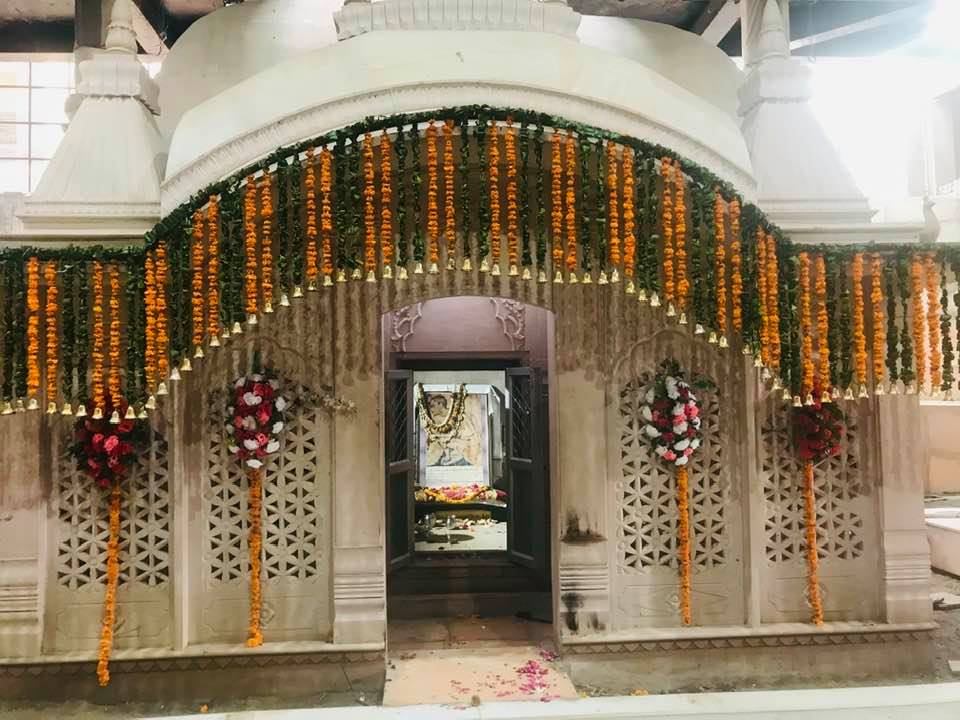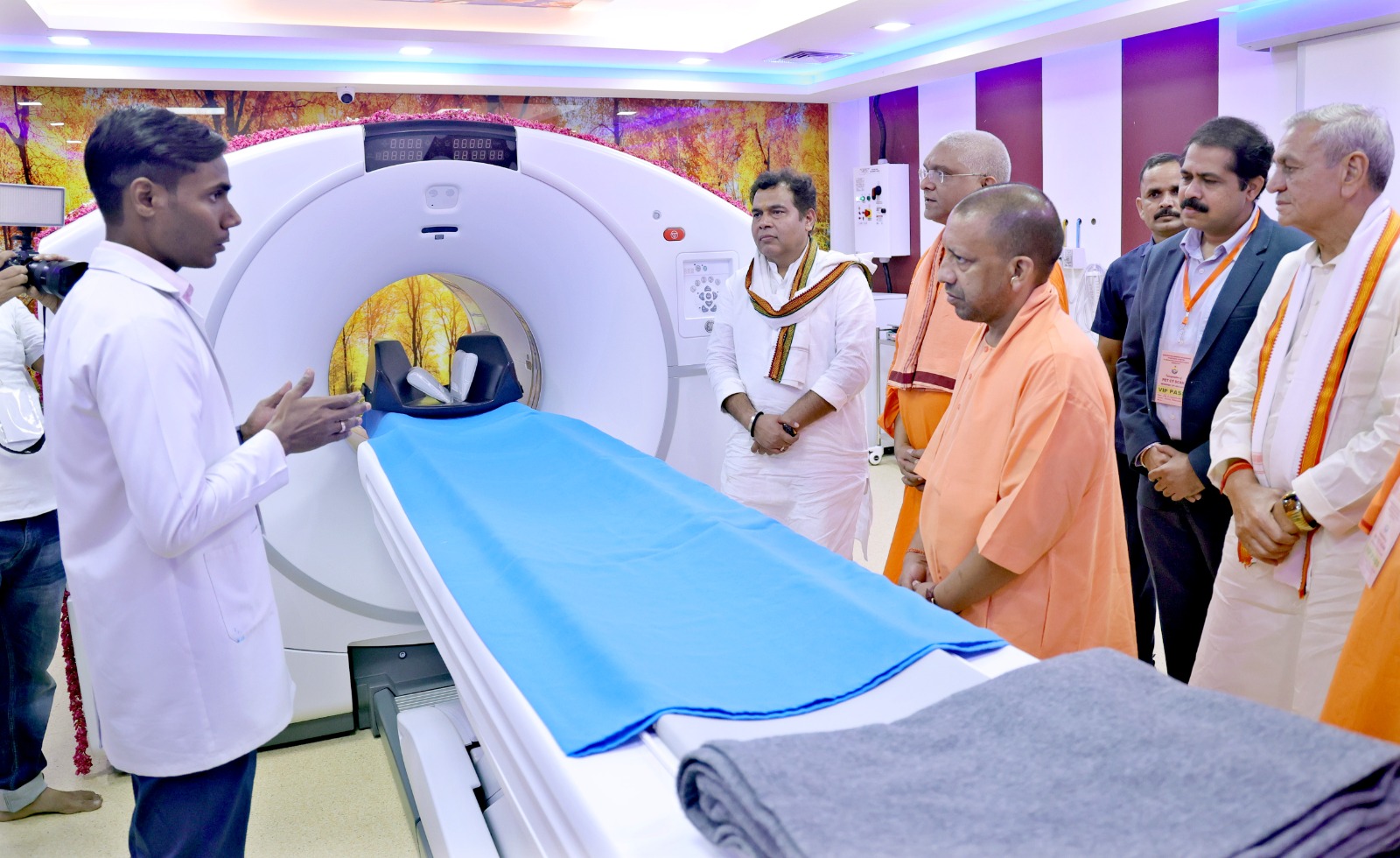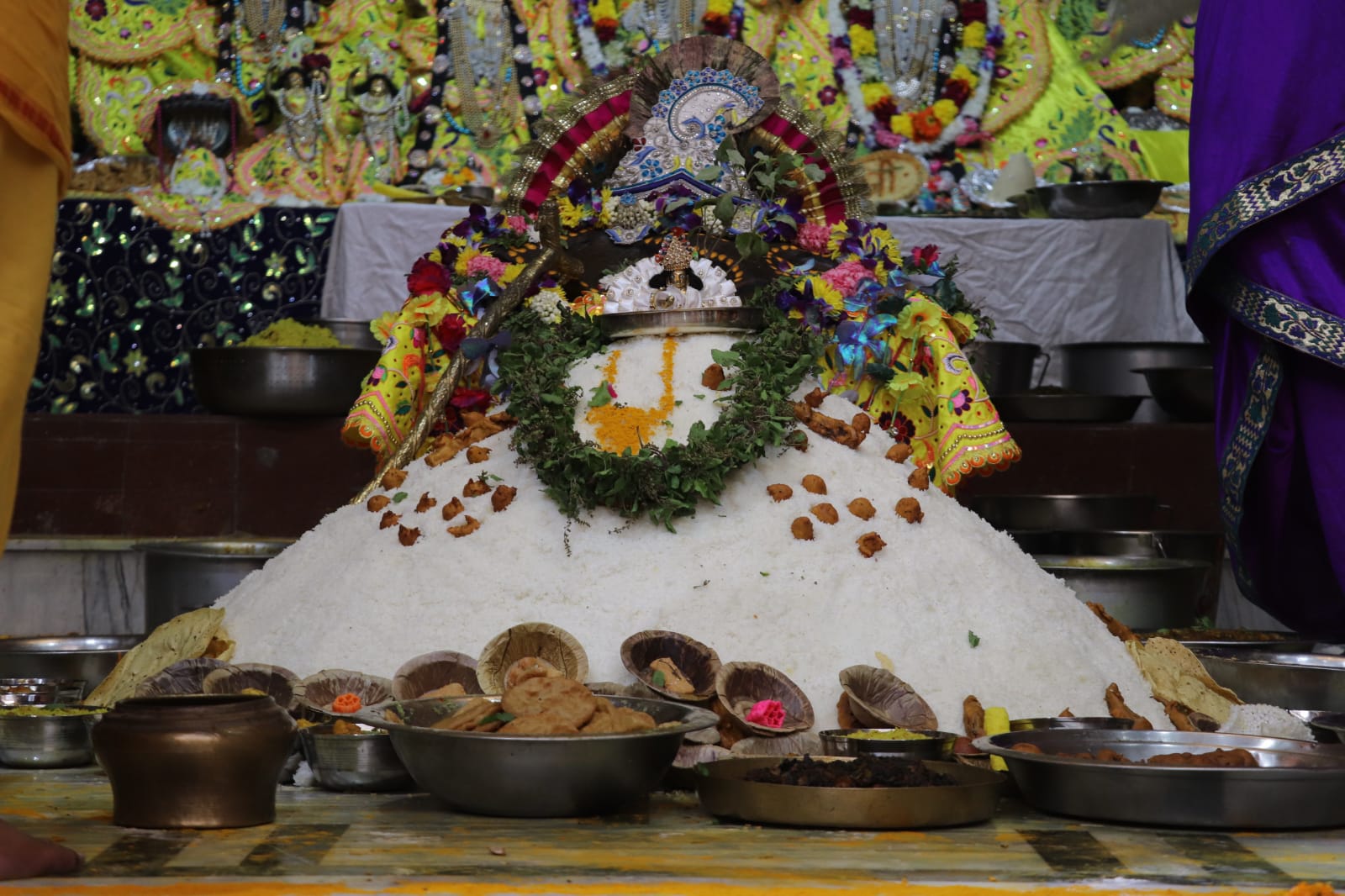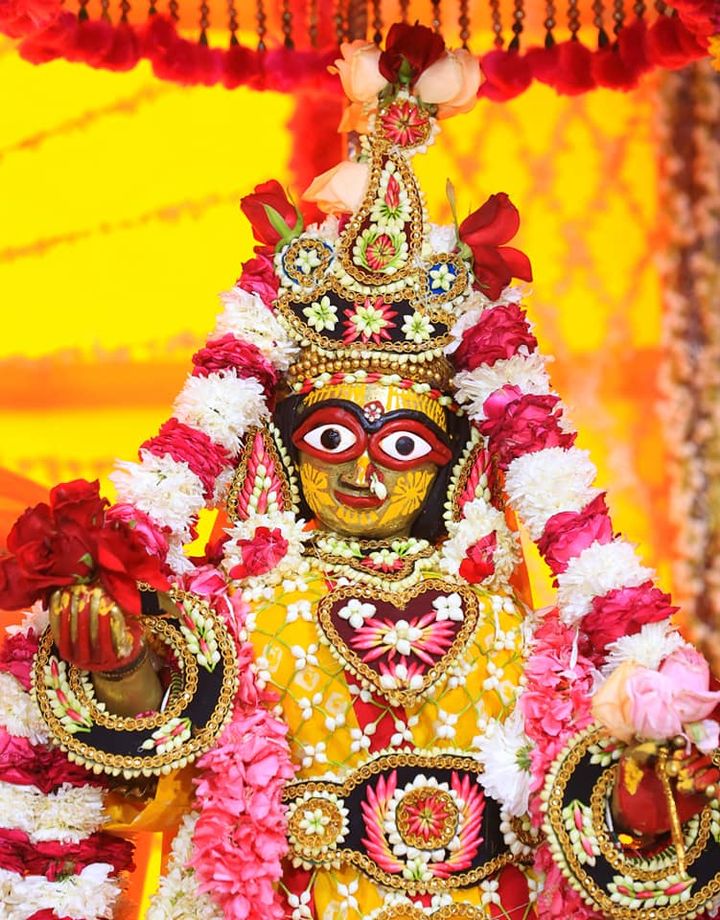Yesterday was the disappearance day of Srila Rupa Goswami. The ‘tirobhav’ mahotsava was celebrated at Shri Damodar Mandir with great pomp amid different devotional events. Suchak Kirtan, discourses, offering of prayers, Samadhi pujan and feast was organised on this occasion.
Vrindavan, 2017.08.04 (From a lecture by B.V. Narayan Maharaj): Even though there are so many great acharyas, Srila Roop Goswami has been attributed with the honor of being that person who has established the mano-‘bhistam, the innermost heart’s desire, of Sri Krishna in the form of Chaitanya Mahaprabhu.
When Sriman Mahaprabhu came to the village of Ramakeli, He met with Srila Roop Goswami and Srila Sanatan Goswami and told them, “Leave your homes and be with Me.” After a short time they left their homes. Sri Chaitanya Mahaprabhu then came from Vrindavan and met with Srila Roop Goswami at Prayag, the confluence of the rivers Yamuna and Ganga. Sri Chaitanya Mahaprabhu told him:
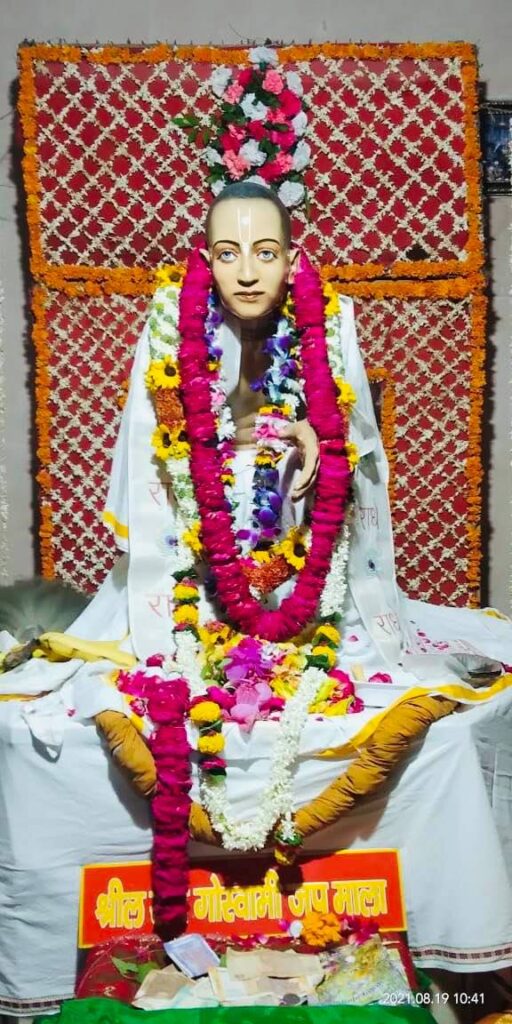
parapara-sunya gabhira bhakti-rasa-sindhu
tomaya cakhaite tara kahi eka bindu
“The ocean of bhakti–ras is so vast that no one can estimate its length and breadth. However, just to help you taste it, I am describing one drop. (Sri Chaitanya-charitamrita, Madhya 19.137)”
Sri Chaitanya gave one drop of the ocean of ras to Srila Roop Goswami, and that one drop was sufficient to inundate millions upon millions of universes. Later, He met with Srila Sanatan Goswami in Varanasi.
After some time, Srila Roop Goswami and Srila Sanatan Goswami came here to Vrindavan and began to perform their bhajan – their hearing, chanting, and remembering about Krishna.
Roop Goswami thought, “In order to fulfill the innermost heart’s desire of Sri Chaitanya Mahaprabhu, I will write a drama. In this drama I will explain the beauty of the union of Srimati Radhika and Sri Krishna in Vrindavan, and also Their separation pastimes, when Lord Krishna leaves Vrindavan and goes to Mathura and Dwarka. I will explain how, by their expansions, Srimati Radhika and all the sakhis somehow or other (by the medium of their expansions) went to Dwarka and became Lord Krishna’s 16,108 queens.”
He intended to write about this, but while he was traveling towards Jagannath Puri he came to the village of Satyabhama-pur. There, Srimati Satyabhama-devi, Lord Krishna’s chief queen, appeared to him in a dream and told him, “Please don’t make only one drama. Please divide it into two parts.”
Then, when Srila Roop Goswami finally arrived at Jagannatha Puri and met with Sri Chaitanya Mahaprabhu, the Lord confirmed what he had heard from Srimati Satyabhama in his dream. Sriman Mahaprabhu told him, “Don’t take Sri Krishna out of Vrindavan.”
krsno ‘nyo yadu-sambhuto yah purnah so ‘sty atah parah
vrndavanam parityajya sa kvacin naiva gacchati
“The Krishna known as Yadu-kumara is Vasudeva Krishna. He is different from the Krishna who is the son of Nand Maharaj. Yadu-kumara Krishna manifests His pastimes in the cities of Mathura and Dwarka, but Krishna the son of Nand Maharaj never at any time leaves Vrindavan.” (Chaitanya-charitamrita Antya 1.67)
“Krishna never leaves Vrindavan. He never even sets one foot outside of Vrindavan.”
Srila Roop Goswami then divided his drama into two parts. The first part is called Vidagdha-madhav, which tells about Krishna’s pastimes in Vrindavan; and in the second part, called Lalit-madhav, He goes to Dwarka and all the gopis of Vrindavan are reunited with Him in the form of the queens of Dwarka.
Why did Srila Roop Goswami do this? This is a very deep siddhanta, conclusive philosophical truth. Srila Kavi Karnapur, a very great devotee, has composed Sri Anand Vrindavan Champu. In this book he described the pastimes of Lord Krishna from His birth up to raas-lila and the Divine Couple’s swing pastimes, and he stopped there. He didn’t go any further than this. He didn’t describe about Krishna going to Mathura or Dwarka, because this separation mood is very difficult to tolerate for the pure devotees. He was thinking, “My Mistress Radhika cannot tolerate this separation, so I will not write about it.”
Srila Roop Goswami, however, has written about the moods of both meeting and separation – because this separation mood is a very deep transcendental ecstatic feeling. At the time of meeting, though Radharani and Krishna are together, something may be forgotten or lost in the heart. On the other hand, at the time of separation, there is complete meeting in new and fresh ways in the heart; and not only inside, but sometimes externally there are sphurtis, temporary visions in which the loved one is actually present.
Knowing all these very deep transcendental established truths, and wanting to establish the desire of Sri Chaitanya Mahaprabhu within the world, Srila Roop Goswami also glorified the mood of separation. Although this mood is very high and has many transcendental features that will not come at the time of meeting, still, it is not our goal of life.
Gaudiya Vaisnavas do not want Sri Sri Radha and Krishna to be eternally separated. What kind of person would want this? No Brajwasi would want it. However, there is a place for this separation mood, and Srila Roop Goswami has explained this in his book, Ujjvala Nilamani: Na vina vipralambha sambhoga pusti masnute. “Without the mood of separation, the mood of meeting will not be nourished” and come to increasingly higher stages. The pastimes of separation are very important because they play the role of nourishing the sweetness of meeting.”
When Srila Roop Goswami was in Puri with Sri Chaitanya Mahaprabhu, the Lord was dancing at the Ratha Yatra festival and uttering a verse from a book of mundane poetry called Sahitya Darpana:
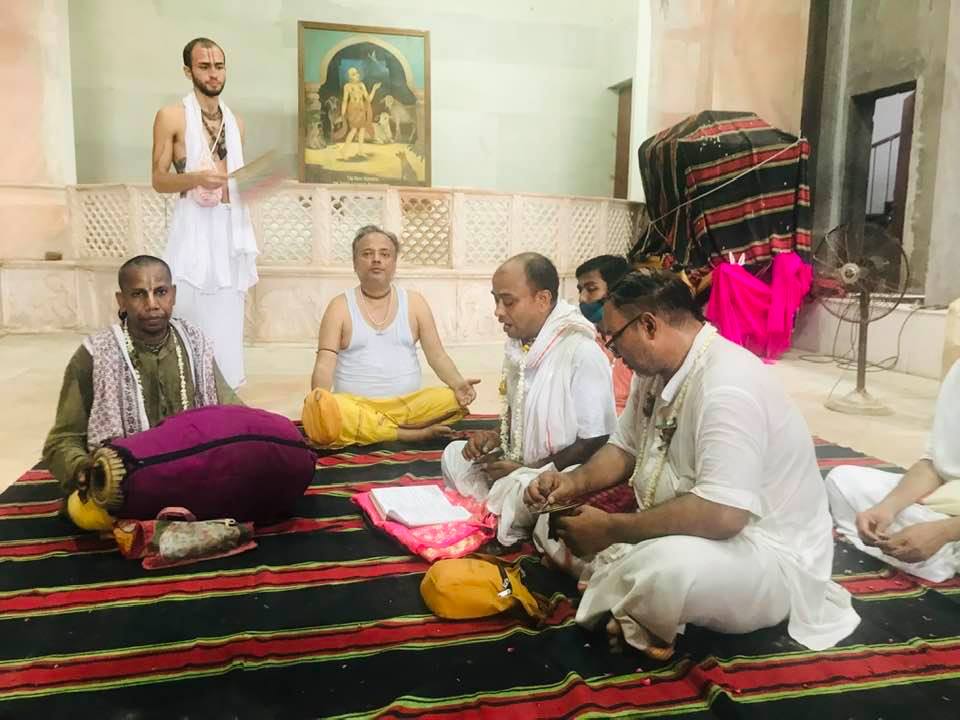
yah kaumara-harah sa eva hi varas ta eva caitra-ksapas
te conmilita-malati-surabhayah praudhah kadambanilah
sa caivasmi tathapi tatra surata-vyapara-lila-vidhau
reva-rodhasi vetasi-taru-tale cetah samutkanthat
“That very personality who stole away my heart during my youth is now again my master. These are the same moonlit nights of the month of Chaitra. The same fragrance of malati flowers is there, and the same sweet breezes are blowing from the kadamba forest. In our intimate relationship, I am also the same lover, yet my mind is not happy here. I am eager to go back to that place on the bank of the Reva under the Vetasi tree. That is my desire.”
No one could understand why Sri Chaitanya Mahaprabhu was uttering this verse and in what mood He was absorbed. There was one young boy there, however, named Roop, who later on became that very same Roop Goswami. There and then, upon hearing this verse from Mahaprabhu, another verse appeared in his own heart, and he wrote down that verse:
priyah so ‘yam krsnah saha-cari kuru-ksetra-militas
tathaham sa radha tad idam ubhayoh sangama-sukham
tathapy antah-khelan-madhura-murali-pancama-juse
mano me kalindi-pulina-vipinaya sprhayati
This is a verse spoken by Srimati Radharani: “My dear friend, now I have met My beloved Krishna on this field of Kurukshetra. I am the same Radha, and now we are meeting together. But still I would like to go to the bank of the Yamuna beneath the trees of the forest there. I wish to hear the vibration of His sweet flute playing the fifth note within that forest of Vrindavan.” (Sri Chaitanya-caritamrta Madhya 1.76)
In this verse Srila Roop Goswami has clarified Sri Chaitanya Mahaprabhu’s inner meaning and thus he revealed to the world the importance of parakiya ras, the mood of paramour love between Lord Krishna and the gopis. Srila Roop Goswami is that very person who established within this world the innermost heart’s desire of Sri Chaitanya Mahaprabhu.
After Sriman Mahaprabhu disappeared from the vision of the world, the discussion of parakiya ras was not prominent. According to scripture, mundane ras, this world’s love between those who are unmarried, is very immoral, illicit and sinful. However, in addition to manifesting the endless varieties and wonder of vipralamba and sambhoga, the meeting and separation pastimes of Radha and Krishna, Srila Roop Goswami also established the superiority of parakiya ras. By using evidence from many different shastras, he proved that Lord Sri Krishna is not an ordinary nayak (lover) and Radhika is not an ordinary nayika (beloved). In other words, when there is meeting between a mundane lover and beloved in the parakiya mood it is very sinful, but Sri Krishna is God Himself, and everything is possible for Him. Therefore, if He is the object of the parakiya-bhava, there is no fault or defect in this. Rather this is the topmost supremely pure manifestation of madhurya-prema, the romantic mood.
Srila Roop Goswami established the fact that Lord Krishna Himself came into this world to taste these mellows, and, as Sri Chaitanya Mahaprabhu, Krishna Himself experienced the parakiya-bhakti-rasa that is within the heart of Srimati Radhika:
anarpita-carim cirat karunayavatirnah kalau
samarpayitum unnatojjvala-rasam sva-bhakti-sriyam
harih purata-sundara-dyuti-kadamba-sandipitah
sada hrdaya-kandare sphuratu vah saci-nandana
“May the Supreme Lord who is known as the son of Srimati Saci-devi be transcendentally situated in the innermost chambers of your heart. Resplendent with the radiance of molten gold, He has appeared in the Age of Kali by His causeless mercy to bestow what no incarnation has ever offered before: the most sublime and radiant mellow of devotional service, the mellow of conjugal love.” (Sri Chaitanya-charitamrita Adi 1.4)
sri-caitanya-mano’bhistam
sthapitam yena bhu-tale
svayam rupah kada mahyam
dadati sva-padantikam
“I was born in the darkest ignorance, and my spiritual master opened my eyes with the torchlight of knowledge. I offer my respectful obeisances unto him. When will Srila Roop Goswami, who has Sri Chaitanya’s heart’s desire within this world, give me shelter under his lotus feet? (prayer by Srila Narottam das Thakur)
These deliberations and philosophical conclusions are extremely deep, and very difficult to understand. It is therefore essential that one come under the guidance of a realized Guru and pure devotees, and give ones full time and energy and enthusiastic work in the service of that Guru and in chanting Harinam, the holy names of Krishna, and performing bhajan. One should also make a great effort to understand and realize the reason for which Srila Roop Goswami appeared in this world and why he wrote so many books like Sri Bhakti-rasamrita-sindhu, Sri Ujjwal-nilamani, Sri Vidagdha-madhav and Sri Lalit-madhav.
The post Srila Roop Goswami’s Disappearance Day appeared first on Vrindavan Today.


